Audiometry Report: Investigation of Hearing Threshold Characteristics
VerifiedAdded on 2022/09/14
|19
|3671
|12
Report
AI Summary
This report investigates the hearing threshold characteristics of the human ear using audiometric equipment, focusing on experimental noise measurement and analysis techniques. The introduction covers the basics of sound, its propagation, and mathematical descriptions in time and frequency domains, also explaining the auditory system's components (outer, middle, and inner ear) and their functions. It describes sound detection, discrimination, and the normal hearing range. The report then discusses various causes of hearing loss, classifying them into conductive, sensorineural, and mixed types, and the methodology includes the apparatus used, such as a soundproof booth, pure tone audiometer, and earphones, along with the procedure for testing hearing thresholds. The goal is to measure and analyze hearing thresholds to understand how the human ear functions and to assess potential hearing loss.
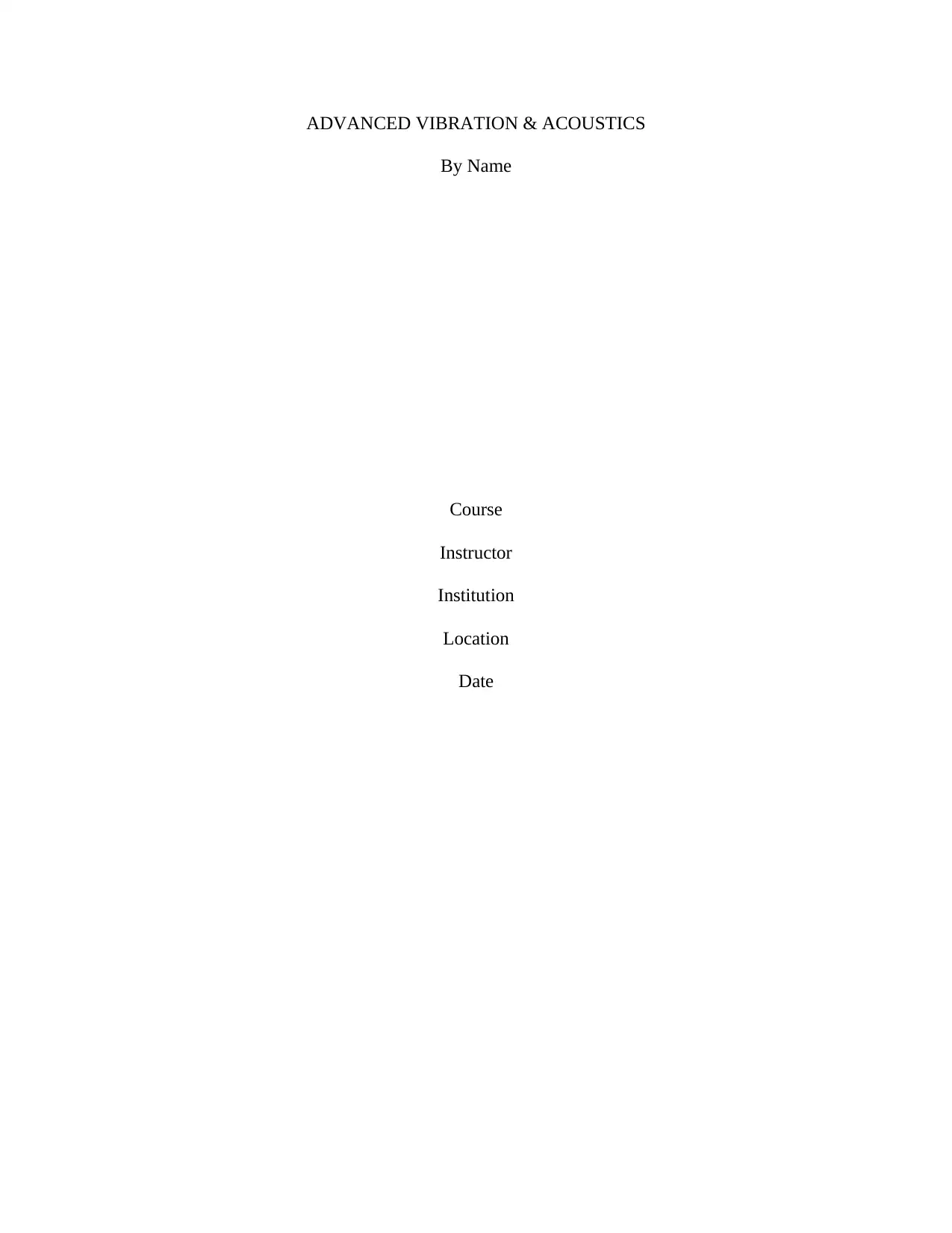
ADVANCED VIBRATION & ACOUSTICS
By Name
Course
Instructor
Institution
Location
Date
By Name
Course
Instructor
Institution
Location
Date
Paraphrase This Document
Need a fresh take? Get an instant paraphrase of this document with our AI Paraphraser
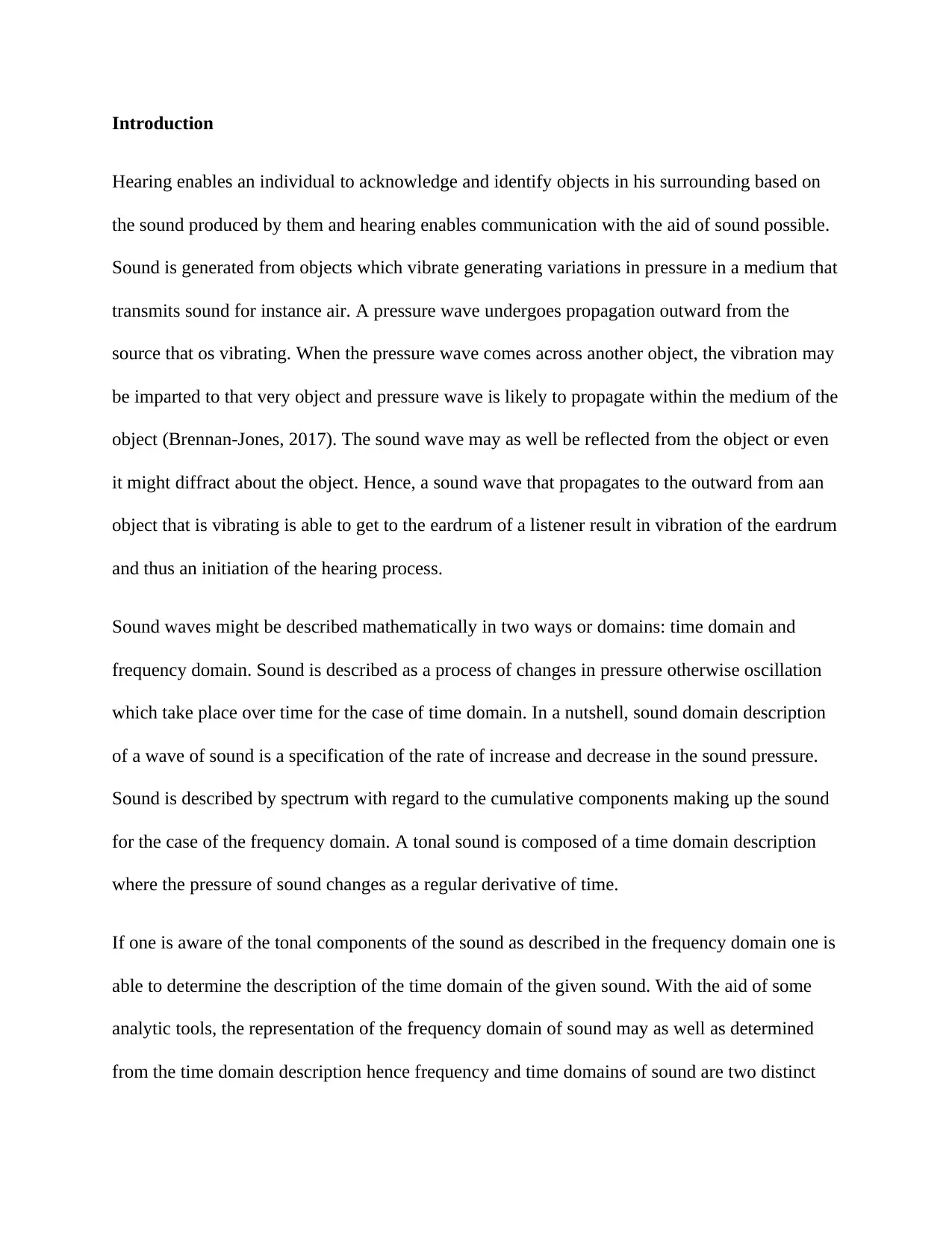
Introduction
Hearing enables an individual to acknowledge and identify objects in his surrounding based on
the sound produced by them and hearing enables communication with the aid of sound possible.
Sound is generated from objects which vibrate generating variations in pressure in a medium that
transmits sound for instance air. A pressure wave undergoes propagation outward from the
source that os vibrating. When the pressure wave comes across another object, the vibration may
be imparted to that very object and pressure wave is likely to propagate within the medium of the
object (Brennan-Jones, 2017). The sound wave may as well be reflected from the object or even
it might diffract about the object. Hence, a sound wave that propagates to the outward from aan
object that is vibrating is able to get to the eardrum of a listener result in vibration of the eardrum
and thus an initiation of the hearing process.
Sound waves might be described mathematically in two ways or domains: time domain and
frequency domain. Sound is described as a process of changes in pressure otherwise oscillation
which take place over time for the case of time domain. In a nutshell, sound domain description
of a wave of sound is a specification of the rate of increase and decrease in the sound pressure.
Sound is described by spectrum with regard to the cumulative components making up the sound
for the case of the frequency domain. A tonal sound is composed of a time domain description
where the pressure of sound changes as a regular derivative of time.
If one is aware of the tonal components of the sound as described in the frequency domain one is
able to determine the description of the time domain of the given sound. With the aid of some
analytic tools, the representation of the frequency domain of sound may as well as determined
from the time domain description hence frequency and time domains of sound are two distinct
Hearing enables an individual to acknowledge and identify objects in his surrounding based on
the sound produced by them and hearing enables communication with the aid of sound possible.
Sound is generated from objects which vibrate generating variations in pressure in a medium that
transmits sound for instance air. A pressure wave undergoes propagation outward from the
source that os vibrating. When the pressure wave comes across another object, the vibration may
be imparted to that very object and pressure wave is likely to propagate within the medium of the
object (Brennan-Jones, 2017). The sound wave may as well be reflected from the object or even
it might diffract about the object. Hence, a sound wave that propagates to the outward from aan
object that is vibrating is able to get to the eardrum of a listener result in vibration of the eardrum
and thus an initiation of the hearing process.
Sound waves might be described mathematically in two ways or domains: time domain and
frequency domain. Sound is described as a process of changes in pressure otherwise oscillation
which take place over time for the case of time domain. In a nutshell, sound domain description
of a wave of sound is a specification of the rate of increase and decrease in the sound pressure.
Sound is described by spectrum with regard to the cumulative components making up the sound
for the case of the frequency domain. A tonal sound is composed of a time domain description
where the pressure of sound changes as a regular derivative of time.
If one is aware of the tonal components of the sound as described in the frequency domain one is
able to determine the description of the time domain of the given sound. With the aid of some
analytic tools, the representation of the frequency domain of sound may as well as determined
from the time domain description hence frequency and time domains of sound are two distinct
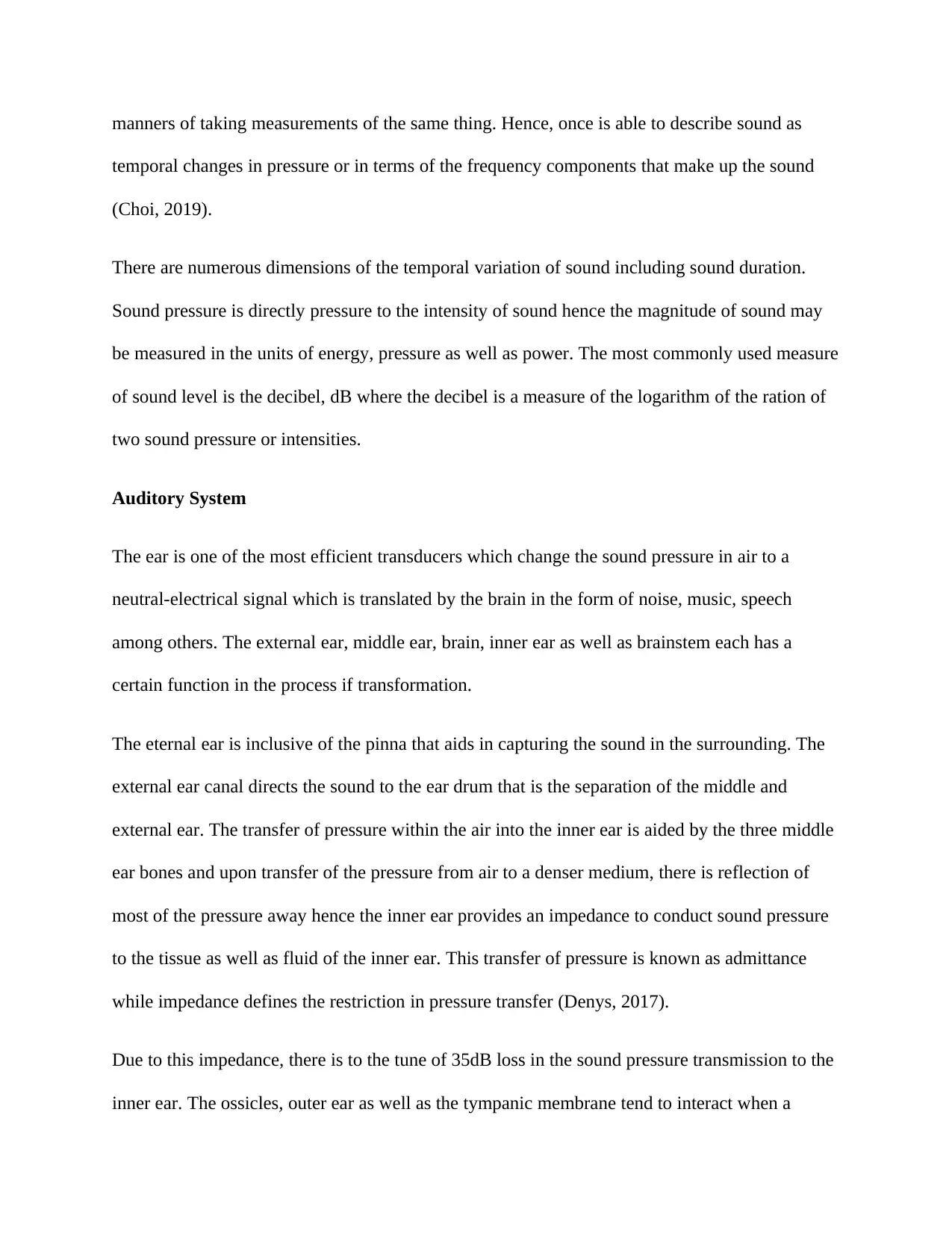
manners of taking measurements of the same thing. Hence, once is able to describe sound as
temporal changes in pressure or in terms of the frequency components that make up the sound
(Choi, 2019).
There are numerous dimensions of the temporal variation of sound including sound duration.
Sound pressure is directly pressure to the intensity of sound hence the magnitude of sound may
be measured in the units of energy, pressure as well as power. The most commonly used measure
of sound level is the decibel, dB where the decibel is a measure of the logarithm of the ration of
two sound pressure or intensities.
Auditory System
The ear is one of the most efficient transducers which change the sound pressure in air to a
neutral-electrical signal which is translated by the brain in the form of noise, music, speech
among others. The external ear, middle ear, brain, inner ear as well as brainstem each has a
certain function in the process if transformation.
The eternal ear is inclusive of the pinna that aids in capturing the sound in the surrounding. The
external ear canal directs the sound to the ear drum that is the separation of the middle and
external ear. The transfer of pressure within the air into the inner ear is aided by the three middle
ear bones and upon transfer of the pressure from air to a denser medium, there is reflection of
most of the pressure away hence the inner ear provides an impedance to conduct sound pressure
to the tissue as well as fluid of the inner ear. This transfer of pressure is known as admittance
while impedance defines the restriction in pressure transfer (Denys, 2017).
Due to this impedance, there is to the tune of 35dB loss in the sound pressure transmission to the
inner ear. The ossicles, outer ear as well as the tympanic membrane tend to interact when a
temporal changes in pressure or in terms of the frequency components that make up the sound
(Choi, 2019).
There are numerous dimensions of the temporal variation of sound including sound duration.
Sound pressure is directly pressure to the intensity of sound hence the magnitude of sound may
be measured in the units of energy, pressure as well as power. The most commonly used measure
of sound level is the decibel, dB where the decibel is a measure of the logarithm of the ration of
two sound pressure or intensities.
Auditory System
The ear is one of the most efficient transducers which change the sound pressure in air to a
neutral-electrical signal which is translated by the brain in the form of noise, music, speech
among others. The external ear, middle ear, brain, inner ear as well as brainstem each has a
certain function in the process if transformation.
The eternal ear is inclusive of the pinna that aids in capturing the sound in the surrounding. The
external ear canal directs the sound to the ear drum that is the separation of the middle and
external ear. The transfer of pressure within the air into the inner ear is aided by the three middle
ear bones and upon transfer of the pressure from air to a denser medium, there is reflection of
most of the pressure away hence the inner ear provides an impedance to conduct sound pressure
to the tissue as well as fluid of the inner ear. This transfer of pressure is known as admittance
while impedance defines the restriction in pressure transfer (Denys, 2017).
Due to this impedance, there is to the tune of 35dB loss in the sound pressure transmission to the
inner ear. The ossicles, outer ear as well as the tympanic membrane tend to interact when a
⊘ This is a preview!⊘
Do you want full access?
Subscribe today to unlock all pages.

Trusted by 1+ million students worldwide
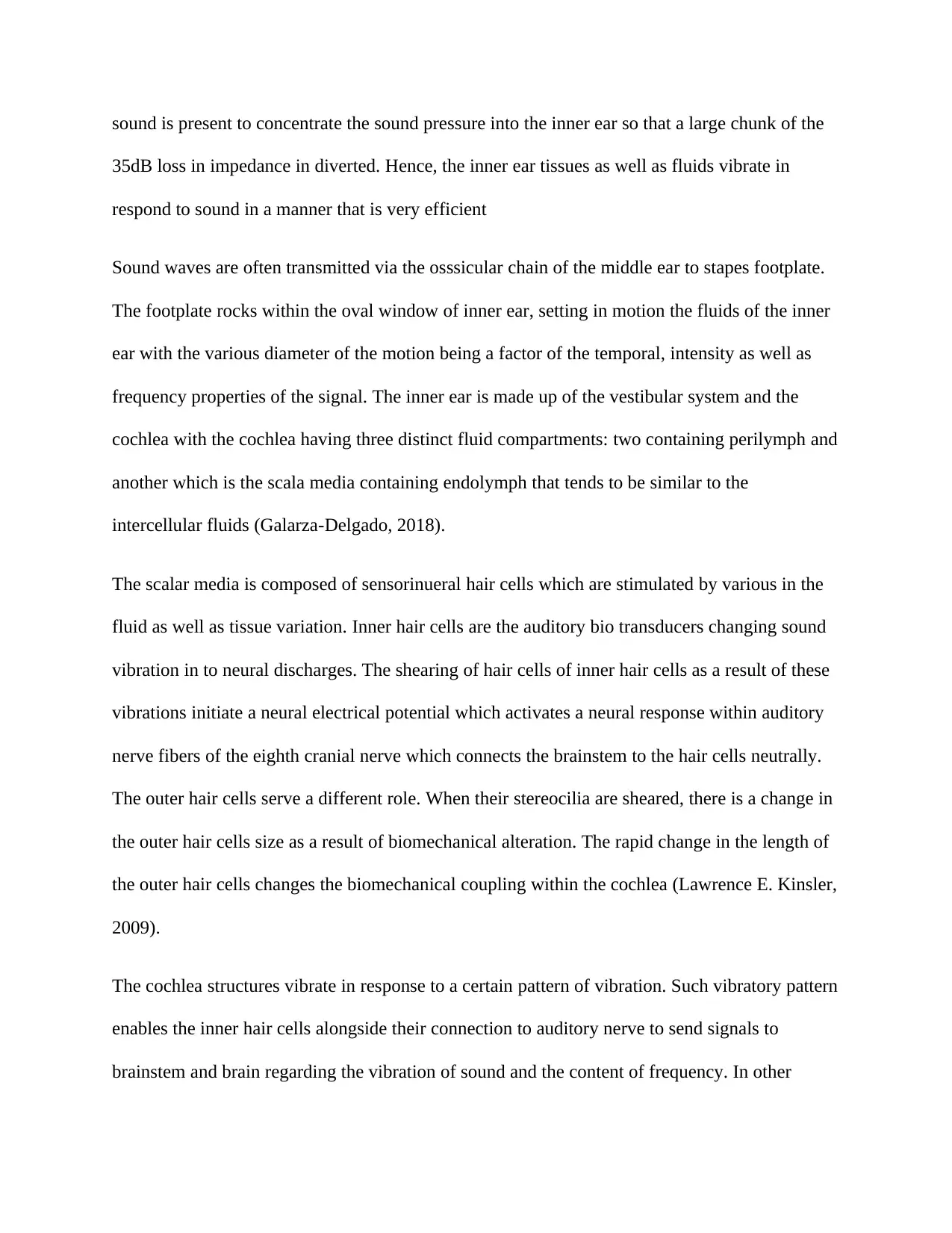
sound is present to concentrate the sound pressure into the inner ear so that a large chunk of the
35dB loss in impedance in diverted. Hence, the inner ear tissues as well as fluids vibrate in
respond to sound in a manner that is very efficient
Sound waves are often transmitted via the osssicular chain of the middle ear to stapes footplate.
The footplate rocks within the oval window of inner ear, setting in motion the fluids of the inner
ear with the various diameter of the motion being a factor of the temporal, intensity as well as
frequency properties of the signal. The inner ear is made up of the vestibular system and the
cochlea with the cochlea having three distinct fluid compartments: two containing perilymph and
another which is the scala media containing endolymph that tends to be similar to the
intercellular fluids (Galarza-Delgado, 2018).
The scalar media is composed of sensorinueral hair cells which are stimulated by various in the
fluid as well as tissue variation. Inner hair cells are the auditory bio transducers changing sound
vibration in to neural discharges. The shearing of hair cells of inner hair cells as a result of these
vibrations initiate a neural electrical potential which activates a neural response within auditory
nerve fibers of the eighth cranial nerve which connects the brainstem to the hair cells neutrally.
The outer hair cells serve a different role. When their stereocilia are sheared, there is a change in
the outer hair cells size as a result of biomechanical alteration. The rapid change in the length of
the outer hair cells changes the biomechanical coupling within the cochlea (Lawrence E. Kinsler,
2009).
The cochlea structures vibrate in response to a certain pattern of vibration. Such vibratory pattern
enables the inner hair cells alongside their connection to auditory nerve to send signals to
brainstem and brain regarding the vibration of sound and the content of frequency. In other
35dB loss in impedance in diverted. Hence, the inner ear tissues as well as fluids vibrate in
respond to sound in a manner that is very efficient
Sound waves are often transmitted via the osssicular chain of the middle ear to stapes footplate.
The footplate rocks within the oval window of inner ear, setting in motion the fluids of the inner
ear with the various diameter of the motion being a factor of the temporal, intensity as well as
frequency properties of the signal. The inner ear is made up of the vestibular system and the
cochlea with the cochlea having three distinct fluid compartments: two containing perilymph and
another which is the scala media containing endolymph that tends to be similar to the
intercellular fluids (Galarza-Delgado, 2018).
The scalar media is composed of sensorinueral hair cells which are stimulated by various in the
fluid as well as tissue variation. Inner hair cells are the auditory bio transducers changing sound
vibration in to neural discharges. The shearing of hair cells of inner hair cells as a result of these
vibrations initiate a neural electrical potential which activates a neural response within auditory
nerve fibers of the eighth cranial nerve which connects the brainstem to the hair cells neutrally.
The outer hair cells serve a different role. When their stereocilia are sheared, there is a change in
the outer hair cells size as a result of biomechanical alteration. The rapid change in the length of
the outer hair cells changes the biomechanical coupling within the cochlea (Lawrence E. Kinsler,
2009).
The cochlea structures vibrate in response to a certain pattern of vibration. Such vibratory pattern
enables the inner hair cells alongside their connection to auditory nerve to send signals to
brainstem and brain regarding the vibration of sound and the content of frequency. In other
Paraphrase This Document
Need a fresh take? Get an instant paraphrase of this document with our AI Paraphraser
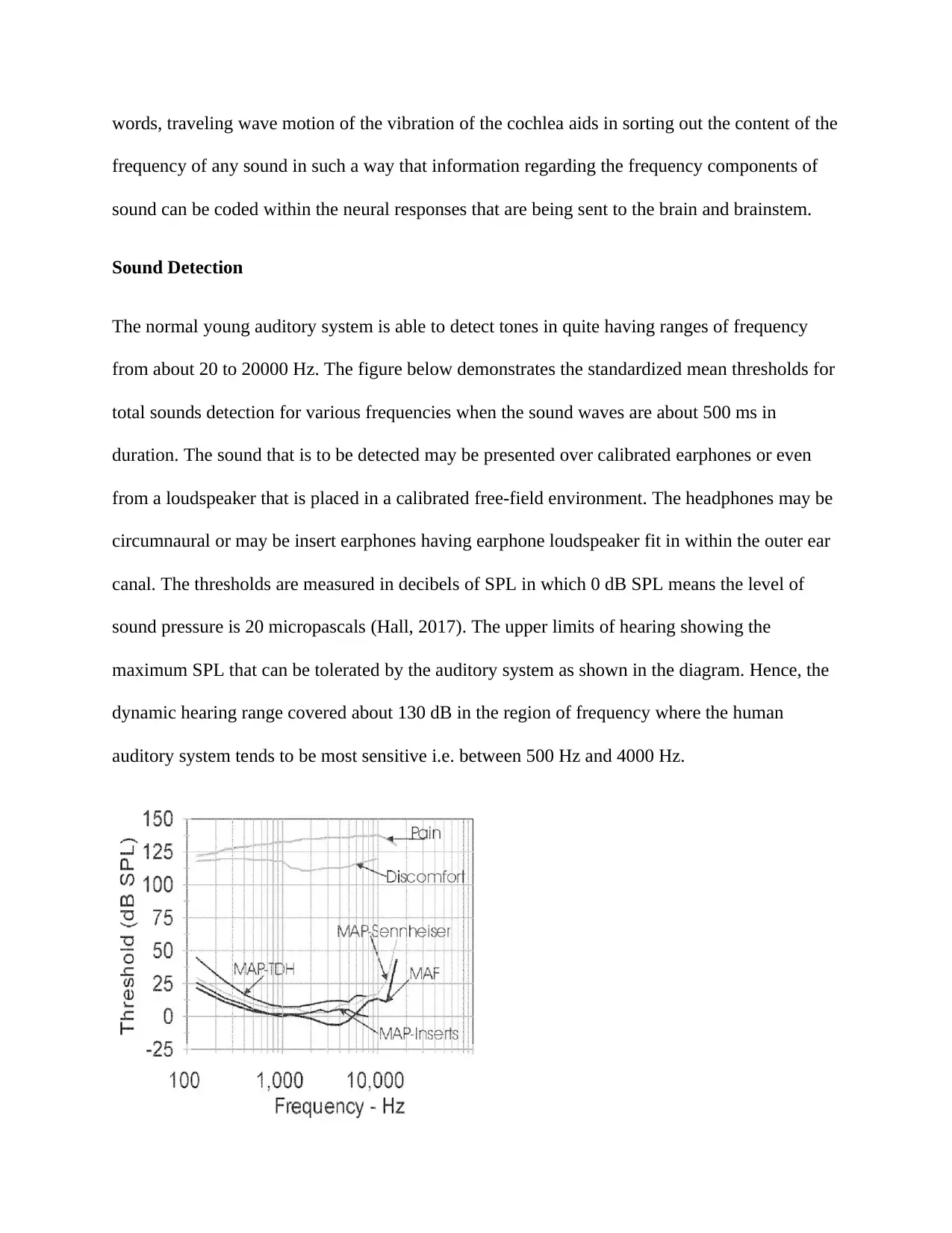
words, traveling wave motion of the vibration of the cochlea aids in sorting out the content of the
frequency of any sound in such a way that information regarding the frequency components of
sound can be coded within the neural responses that are being sent to the brain and brainstem.
Sound Detection
The normal young auditory system is able to detect tones in quite having ranges of frequency
from about 20 to 20000 Hz. The figure below demonstrates the standardized mean thresholds for
total sounds detection for various frequencies when the sound waves are about 500 ms in
duration. The sound that is to be detected may be presented over calibrated earphones or even
from a loudspeaker that is placed in a calibrated free-field environment. The headphones may be
circumnaural or may be insert earphones having earphone loudspeaker fit in within the outer ear
canal. The thresholds are measured in decibels of SPL in which 0 dB SPL means the level of
sound pressure is 20 micropascals (Hall, 2017). The upper limits of hearing showing the
maximum SPL that can be tolerated by the auditory system as shown in the diagram. Hence, the
dynamic hearing range covered about 130 dB in the region of frequency where the human
auditory system tends to be most sensitive i.e. between 500 Hz and 4000 Hz.
frequency of any sound in such a way that information regarding the frequency components of
sound can be coded within the neural responses that are being sent to the brain and brainstem.
Sound Detection
The normal young auditory system is able to detect tones in quite having ranges of frequency
from about 20 to 20000 Hz. The figure below demonstrates the standardized mean thresholds for
total sounds detection for various frequencies when the sound waves are about 500 ms in
duration. The sound that is to be detected may be presented over calibrated earphones or even
from a loudspeaker that is placed in a calibrated free-field environment. The headphones may be
circumnaural or may be insert earphones having earphone loudspeaker fit in within the outer ear
canal. The thresholds are measured in decibels of SPL in which 0 dB SPL means the level of
sound pressure is 20 micropascals (Hall, 2017). The upper limits of hearing showing the
maximum SPL that can be tolerated by the auditory system as shown in the diagram. Hence, the
dynamic hearing range covered about 130 dB in the region of frequency where the human
auditory system tends to be most sensitive i.e. between 500 Hz and 4000 Hz.
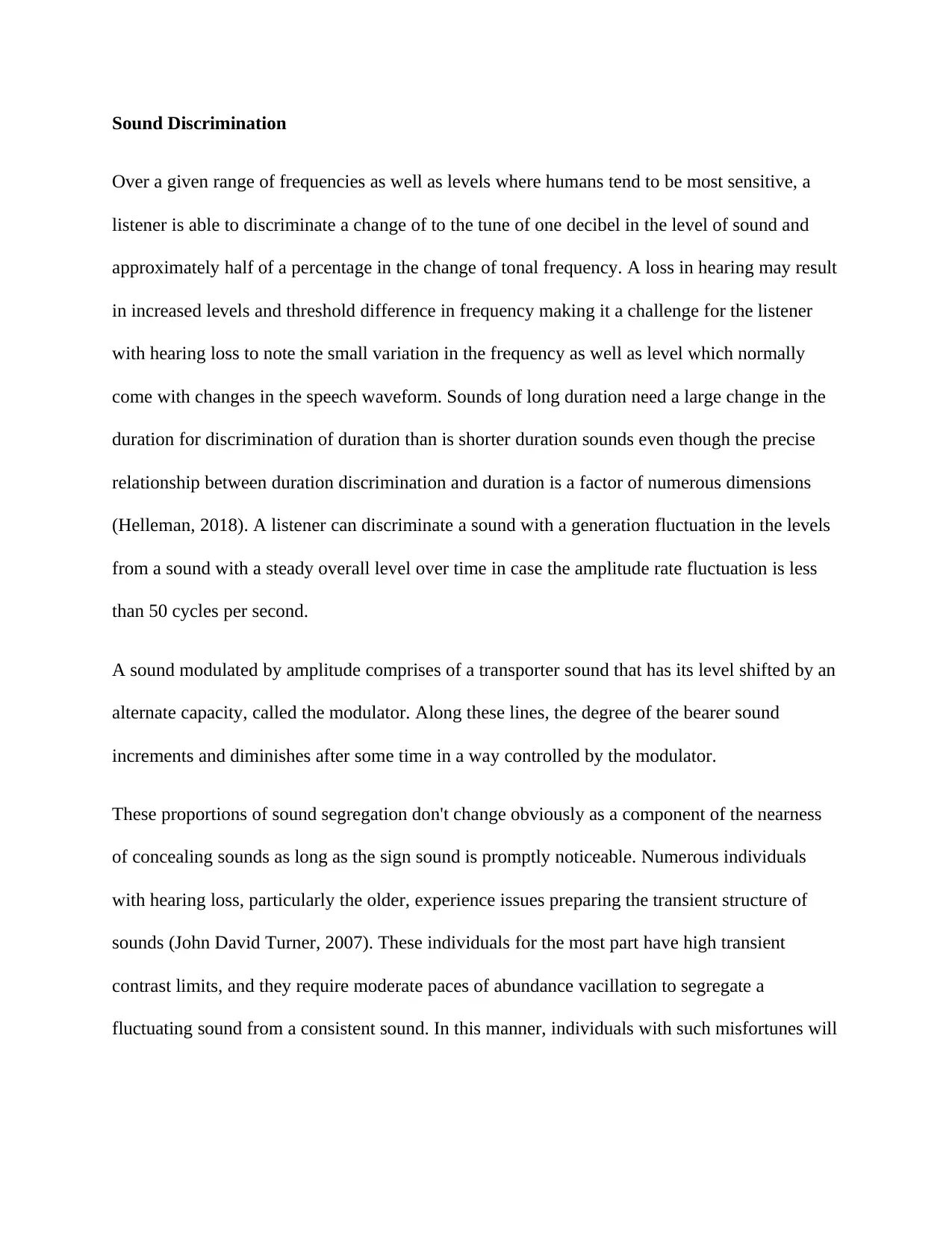
Sound Discrimination
Over a given range of frequencies as well as levels where humans tend to be most sensitive, a
listener is able to discriminate a change of to the tune of one decibel in the level of sound and
approximately half of a percentage in the change of tonal frequency. A loss in hearing may result
in increased levels and threshold difference in frequency making it a challenge for the listener
with hearing loss to note the small variation in the frequency as well as level which normally
come with changes in the speech waveform. Sounds of long duration need a large change in the
duration for discrimination of duration than is shorter duration sounds even though the precise
relationship between duration discrimination and duration is a factor of numerous dimensions
(Helleman, 2018). A listener can discriminate a sound with a generation fluctuation in the levels
from a sound with a steady overall level over time in case the amplitude rate fluctuation is less
than 50 cycles per second.
A sound modulated by amplitude comprises of a transporter sound that has its level shifted by an
alternate capacity, called the modulator. Along these lines, the degree of the bearer sound
increments and diminishes after some time in a way controlled by the modulator.
These proportions of sound segregation don't change obviously as a component of the nearness
of concealing sounds as long as the sign sound is promptly noticeable. Numerous individuals
with hearing loss, particularly the older, experience issues preparing the transient structure of
sounds (John David Turner, 2007). These individuals for the most part have high transient
contrast limits, and they require moderate paces of abundance vacillation to segregate a
fluctuating sound from a consistent sound. In this manner, individuals with such misfortunes will
Over a given range of frequencies as well as levels where humans tend to be most sensitive, a
listener is able to discriminate a change of to the tune of one decibel in the level of sound and
approximately half of a percentage in the change of tonal frequency. A loss in hearing may result
in increased levels and threshold difference in frequency making it a challenge for the listener
with hearing loss to note the small variation in the frequency as well as level which normally
come with changes in the speech waveform. Sounds of long duration need a large change in the
duration for discrimination of duration than is shorter duration sounds even though the precise
relationship between duration discrimination and duration is a factor of numerous dimensions
(Helleman, 2018). A listener can discriminate a sound with a generation fluctuation in the levels
from a sound with a steady overall level over time in case the amplitude rate fluctuation is less
than 50 cycles per second.
A sound modulated by amplitude comprises of a transporter sound that has its level shifted by an
alternate capacity, called the modulator. Along these lines, the degree of the bearer sound
increments and diminishes after some time in a way controlled by the modulator.
These proportions of sound segregation don't change obviously as a component of the nearness
of concealing sounds as long as the sign sound is promptly noticeable. Numerous individuals
with hearing loss, particularly the older, experience issues preparing the transient structure of
sounds (John David Turner, 2007). These individuals for the most part have high transient
contrast limits, and they require moderate paces of abundance vacillation to segregate a
fluctuating sound from a consistent sound. In this manner, individuals with such misfortunes will
⊘ This is a preview!⊘
Do you want full access?
Subscribe today to unlock all pages.

Trusted by 1+ million students worldwide
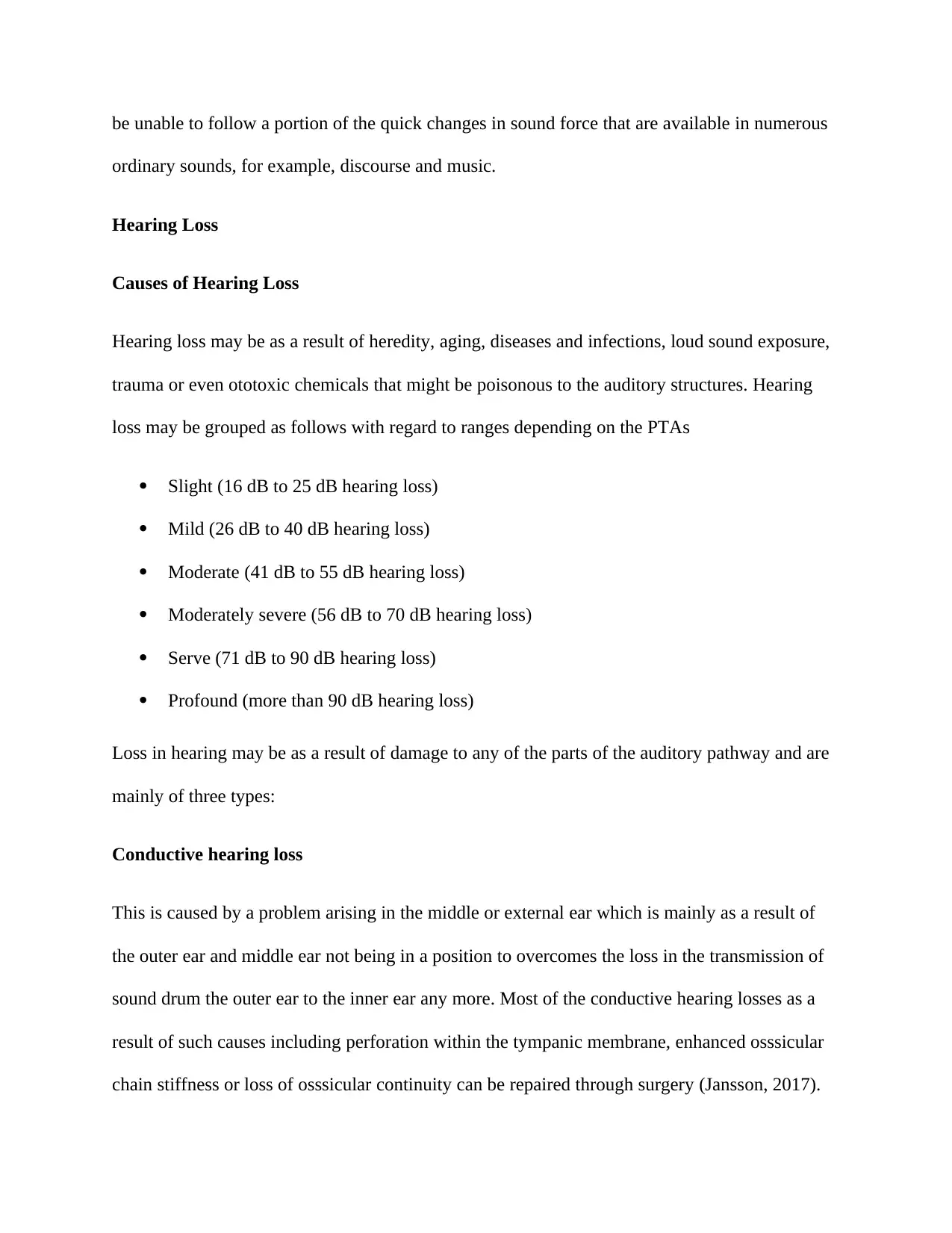
be unable to follow a portion of the quick changes in sound force that are available in numerous
ordinary sounds, for example, discourse and music.
Hearing Loss
Causes of Hearing Loss
Hearing loss may be as a result of heredity, aging, diseases and infections, loud sound exposure,
trauma or even ototoxic chemicals that might be poisonous to the auditory structures. Hearing
loss may be grouped as follows with regard to ranges depending on the PTAs
Slight (16 dB to 25 dB hearing loss)
Mild (26 dB to 40 dB hearing loss)
Moderate (41 dB to 55 dB hearing loss)
Moderately severe (56 dB to 70 dB hearing loss)
Serve (71 dB to 90 dB hearing loss)
Profound (more than 90 dB hearing loss)
Loss in hearing may be as a result of damage to any of the parts of the auditory pathway and are
mainly of three types:
Conductive hearing loss
This is caused by a problem arising in the middle or external ear which is mainly as a result of
the outer ear and middle ear not being in a position to overcomes the loss in the transmission of
sound drum the outer ear to the inner ear any more. Most of the conductive hearing losses as a
result of such causes including perforation within the tympanic membrane, enhanced osssicular
chain stiffness or loss of osssicular continuity can be repaired through surgery (Jansson, 2017).
ordinary sounds, for example, discourse and music.
Hearing Loss
Causes of Hearing Loss
Hearing loss may be as a result of heredity, aging, diseases and infections, loud sound exposure,
trauma or even ototoxic chemicals that might be poisonous to the auditory structures. Hearing
loss may be grouped as follows with regard to ranges depending on the PTAs
Slight (16 dB to 25 dB hearing loss)
Mild (26 dB to 40 dB hearing loss)
Moderate (41 dB to 55 dB hearing loss)
Moderately severe (56 dB to 70 dB hearing loss)
Serve (71 dB to 90 dB hearing loss)
Profound (more than 90 dB hearing loss)
Loss in hearing may be as a result of damage to any of the parts of the auditory pathway and are
mainly of three types:
Conductive hearing loss
This is caused by a problem arising in the middle or external ear which is mainly as a result of
the outer ear and middle ear not being in a position to overcomes the loss in the transmission of
sound drum the outer ear to the inner ear any more. Most of the conductive hearing losses as a
result of such causes including perforation within the tympanic membrane, enhanced osssicular
chain stiffness or loss of osssicular continuity can be repaired through surgery (Jansson, 2017).
Paraphrase This Document
Need a fresh take? Get an instant paraphrase of this document with our AI Paraphraser
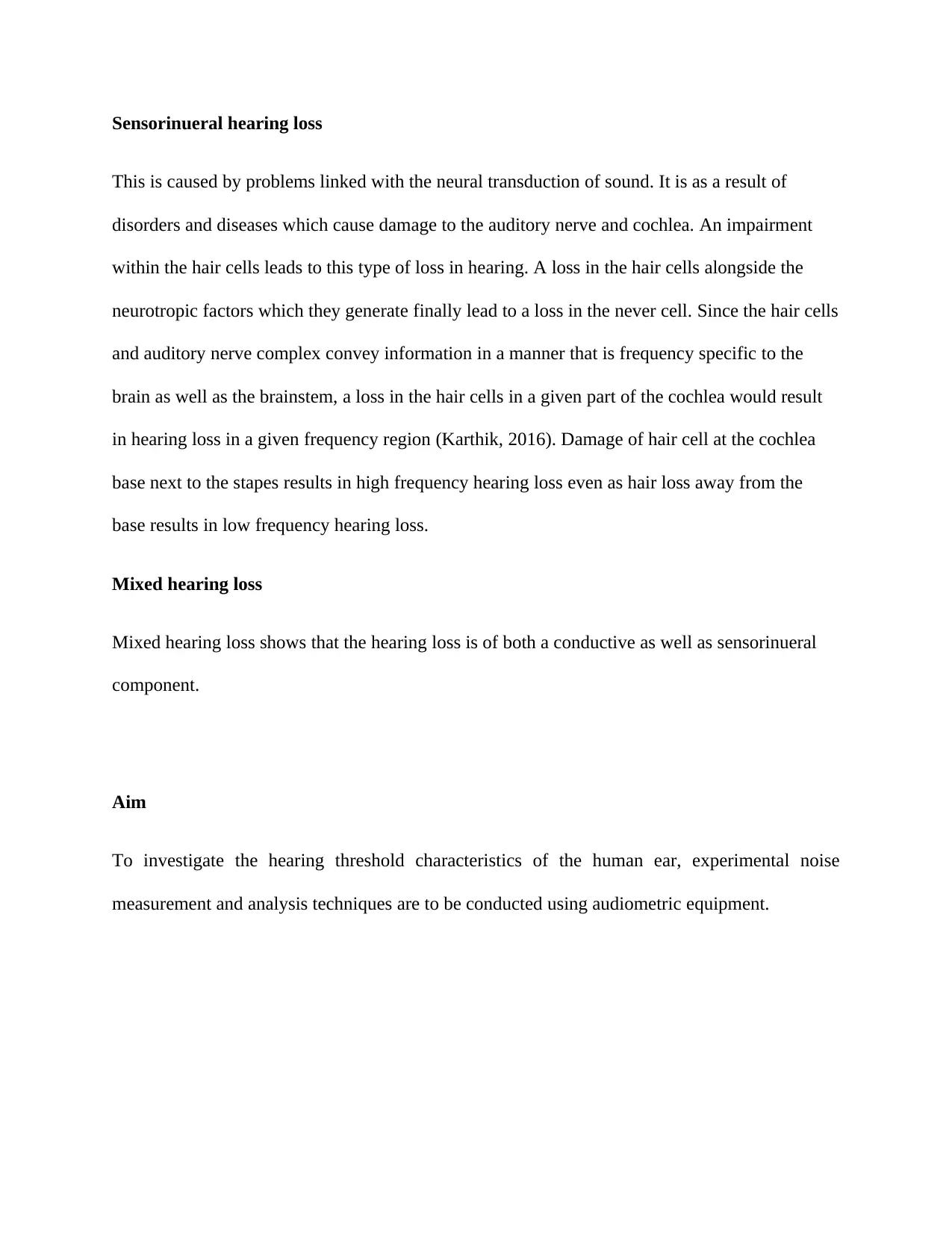
Sensorinueral hearing loss
This is caused by problems linked with the neural transduction of sound. It is as a result of
disorders and diseases which cause damage to the auditory nerve and cochlea. An impairment
within the hair cells leads to this type of loss in hearing. A loss in the hair cells alongside the
neurotropic factors which they generate finally lead to a loss in the never cell. Since the hair cells
and auditory nerve complex convey information in a manner that is frequency specific to the
brain as well as the brainstem, a loss in the hair cells in a given part of the cochlea would result
in hearing loss in a given frequency region (Karthik, 2016). Damage of hair cell at the cochlea
base next to the stapes results in high frequency hearing loss even as hair loss away from the
base results in low frequency hearing loss.
Mixed hearing loss
Mixed hearing loss shows that the hearing loss is of both a conductive as well as sensorinueral
component.
Aim
To investigate the hearing threshold characteristics of the human ear, experimental noise
measurement and analysis techniques are to be conducted using audiometric equipment.
This is caused by problems linked with the neural transduction of sound. It is as a result of
disorders and diseases which cause damage to the auditory nerve and cochlea. An impairment
within the hair cells leads to this type of loss in hearing. A loss in the hair cells alongside the
neurotropic factors which they generate finally lead to a loss in the never cell. Since the hair cells
and auditory nerve complex convey information in a manner that is frequency specific to the
brain as well as the brainstem, a loss in the hair cells in a given part of the cochlea would result
in hearing loss in a given frequency region (Karthik, 2016). Damage of hair cell at the cochlea
base next to the stapes results in high frequency hearing loss even as hair loss away from the
base results in low frequency hearing loss.
Mixed hearing loss
Mixed hearing loss shows that the hearing loss is of both a conductive as well as sensorinueral
component.
Aim
To investigate the hearing threshold characteristics of the human ear, experimental noise
measurement and analysis techniques are to be conducted using audiometric equipment.
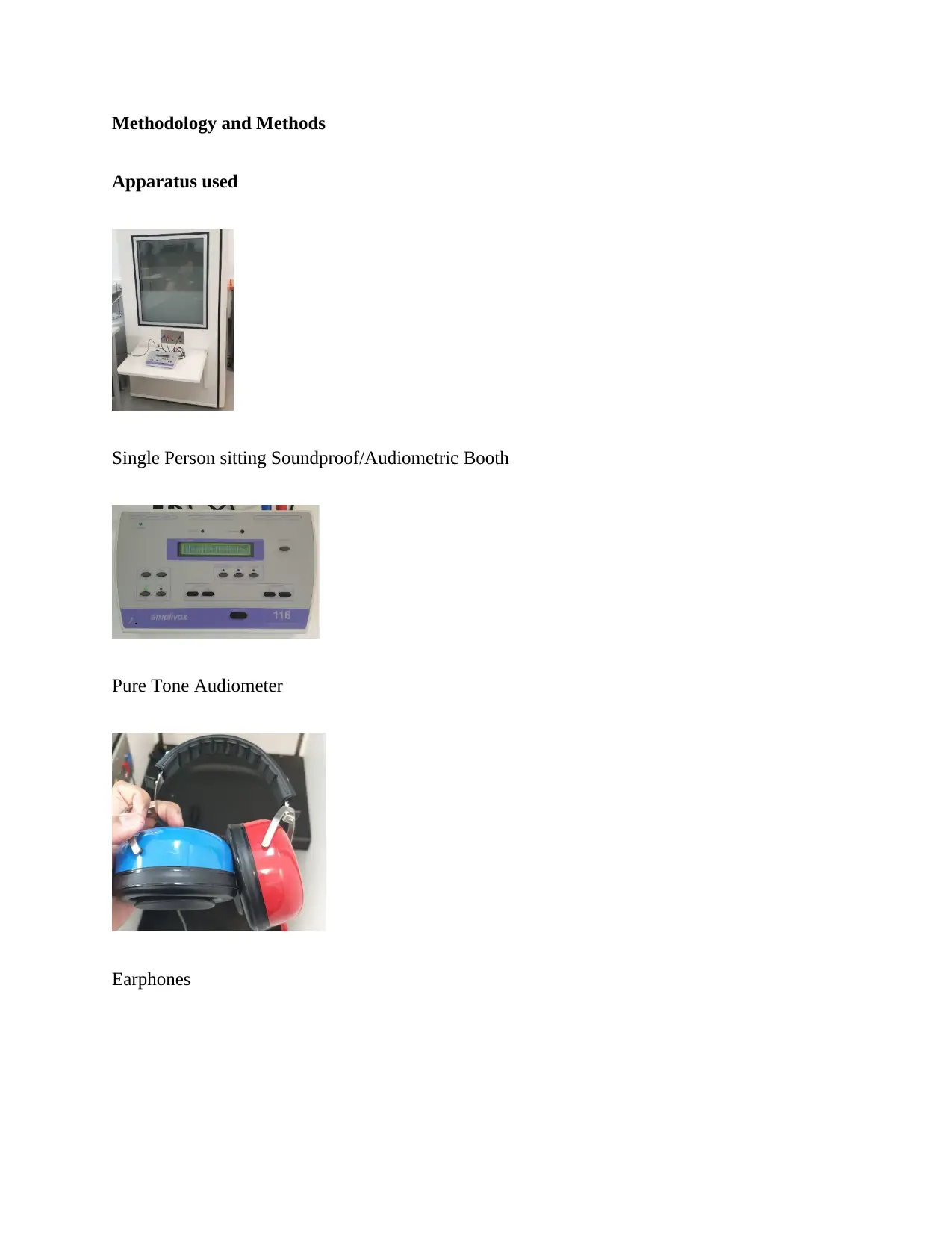
Methodology and Methods
Apparatus used
Single Person sitting Soundproof/Audiometric Booth
Pure Tone Audiometer
Earphones
Apparatus used
Single Person sitting Soundproof/Audiometric Booth
Pure Tone Audiometer
Earphones
⊘ This is a preview!⊘
Do you want full access?
Subscribe today to unlock all pages.

Trusted by 1+ million students worldwide
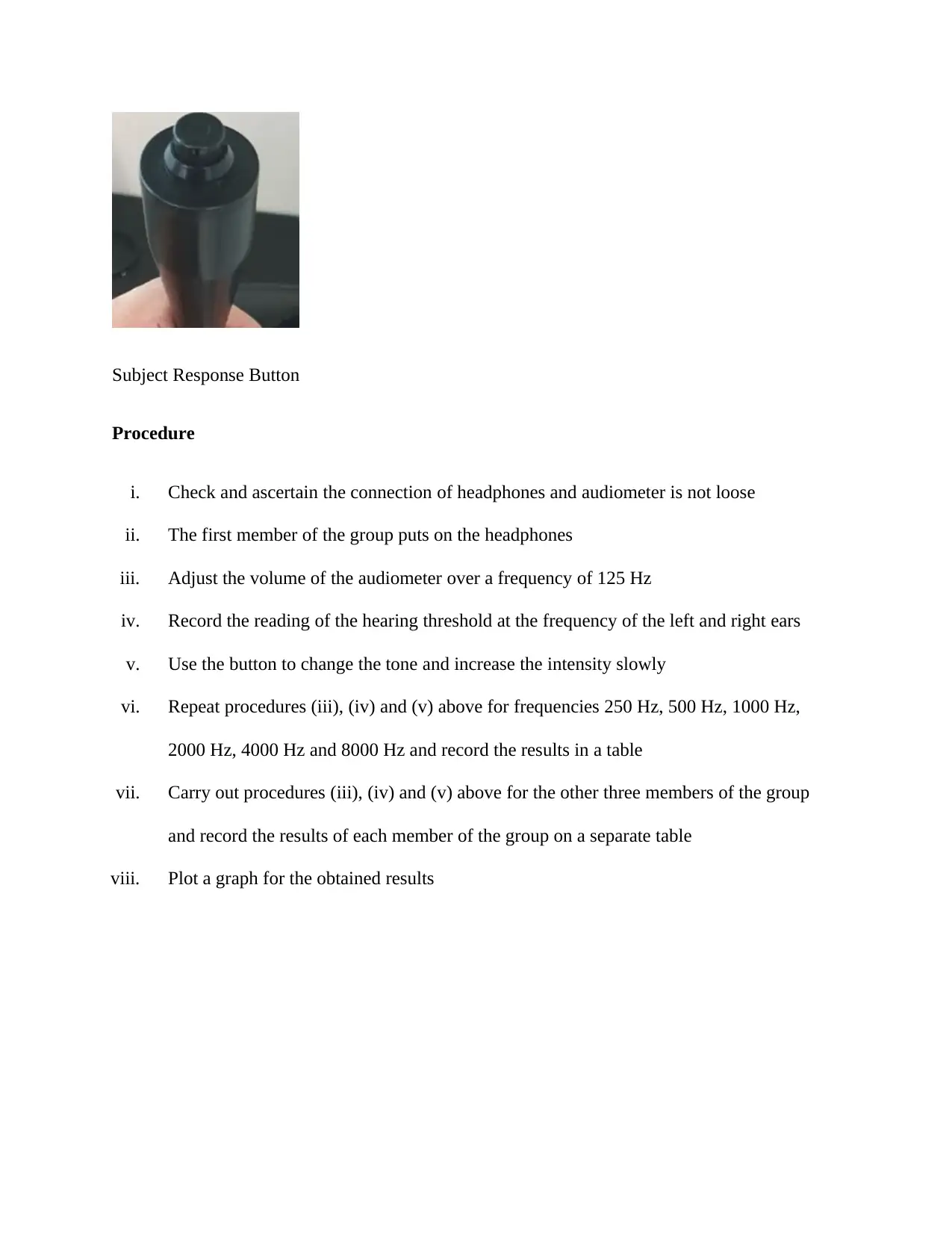
Subject Response Button
Procedure
i. Check and ascertain the connection of headphones and audiometer is not loose
ii. The first member of the group puts on the headphones
iii. Adjust the volume of the audiometer over a frequency of 125 Hz
iv. Record the reading of the hearing threshold at the frequency of the left and right ears
v. Use the button to change the tone and increase the intensity slowly
vi. Repeat procedures (iii), (iv) and (v) above for frequencies 250 Hz, 500 Hz, 1000 Hz,
2000 Hz, 4000 Hz and 8000 Hz and record the results in a table
vii. Carry out procedures (iii), (iv) and (v) above for the other three members of the group
and record the results of each member of the group on a separate table
viii. Plot a graph for the obtained results
Procedure
i. Check and ascertain the connection of headphones and audiometer is not loose
ii. The first member of the group puts on the headphones
iii. Adjust the volume of the audiometer over a frequency of 125 Hz
iv. Record the reading of the hearing threshold at the frequency of the left and right ears
v. Use the button to change the tone and increase the intensity slowly
vi. Repeat procedures (iii), (iv) and (v) above for frequencies 250 Hz, 500 Hz, 1000 Hz,
2000 Hz, 4000 Hz and 8000 Hz and record the results in a table
vii. Carry out procedures (iii), (iv) and (v) above for the other three members of the group
and record the results of each member of the group on a separate table
viii. Plot a graph for the obtained results
Paraphrase This Document
Need a fresh take? Get an instant paraphrase of this document with our AI Paraphraser
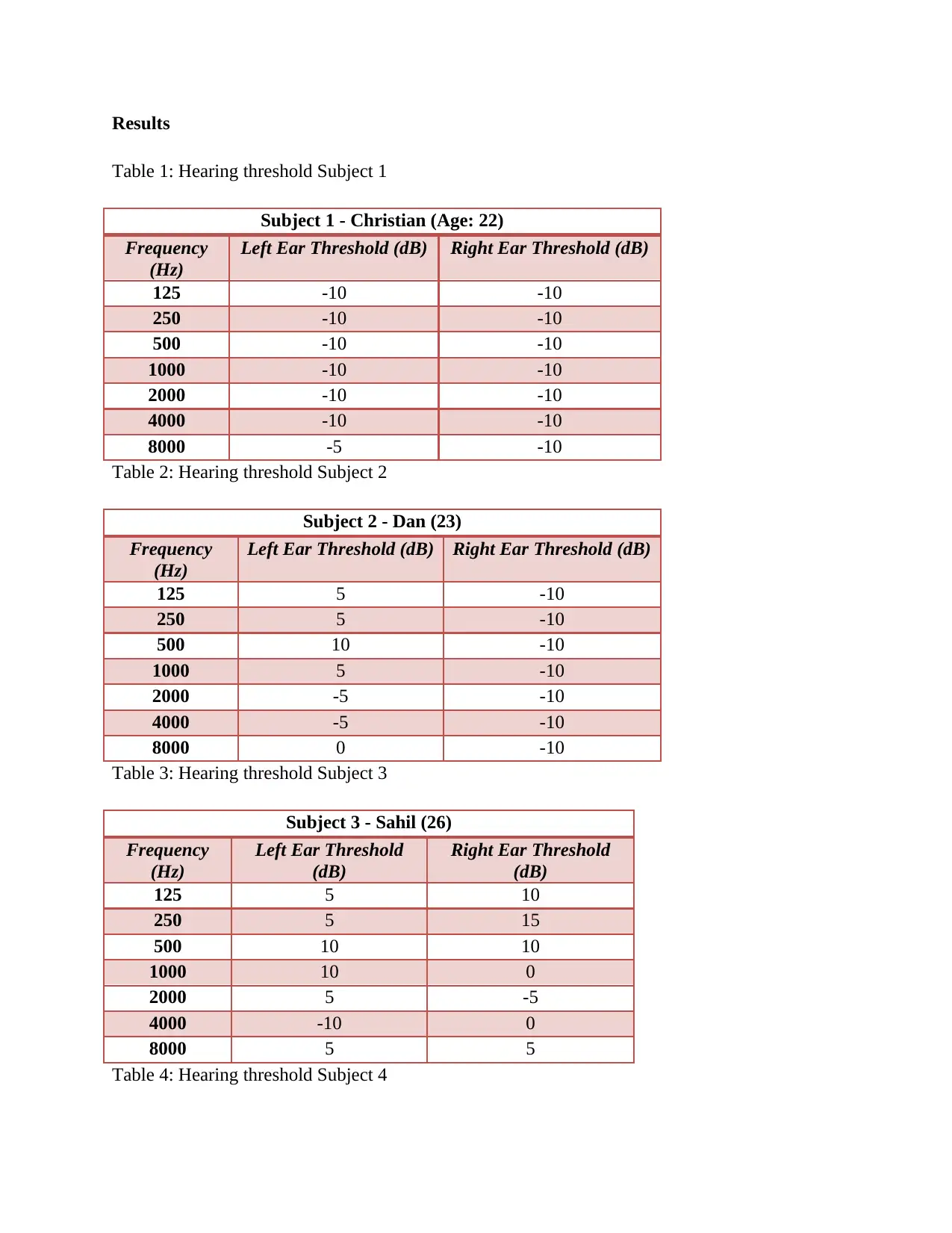
Results
Table 1: Hearing threshold Subject 1
Subject 1 - Christian (Age: 22)
Frequency
(Hz)
Left Ear Threshold (dB) Right Ear Threshold (dB)
125 -10 -10
250 -10 -10
500 -10 -10
1000 -10 -10
2000 -10 -10
4000 -10 -10
8000 -5 -10
Table 2: Hearing threshold Subject 2
Subject 2 - Dan (23)
Frequency
(Hz)
Left Ear Threshold (dB) Right Ear Threshold (dB)
125 5 -10
250 5 -10
500 10 -10
1000 5 -10
2000 -5 -10
4000 -5 -10
8000 0 -10
Table 3: Hearing threshold Subject 3
Subject 3 - Sahil (26)
Frequency
(Hz)
Left Ear Threshold
(dB)
Right Ear Threshold
(dB)
125 5 10
250 5 15
500 10 10
1000 10 0
2000 5 -5
4000 -10 0
8000 5 5
Table 4: Hearing threshold Subject 4
Table 1: Hearing threshold Subject 1
Subject 1 - Christian (Age: 22)
Frequency
(Hz)
Left Ear Threshold (dB) Right Ear Threshold (dB)
125 -10 -10
250 -10 -10
500 -10 -10
1000 -10 -10
2000 -10 -10
4000 -10 -10
8000 -5 -10
Table 2: Hearing threshold Subject 2
Subject 2 - Dan (23)
Frequency
(Hz)
Left Ear Threshold (dB) Right Ear Threshold (dB)
125 5 -10
250 5 -10
500 10 -10
1000 5 -10
2000 -5 -10
4000 -5 -10
8000 0 -10
Table 3: Hearing threshold Subject 3
Subject 3 - Sahil (26)
Frequency
(Hz)
Left Ear Threshold
(dB)
Right Ear Threshold
(dB)
125 5 10
250 5 15
500 10 10
1000 10 0
2000 5 -5
4000 -10 0
8000 5 5
Table 4: Hearing threshold Subject 4
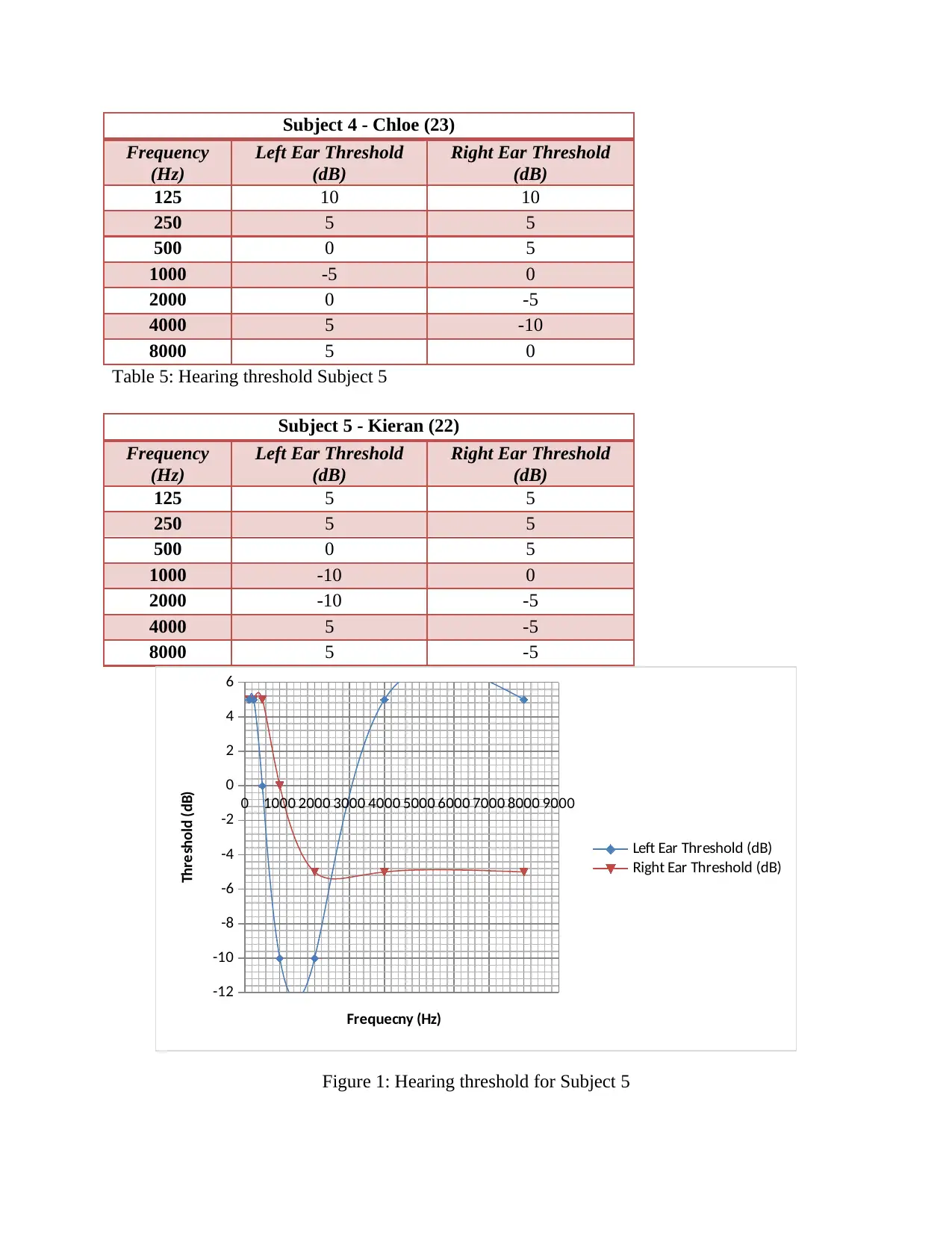
Subject 4 - Chloe (23)
Frequency
(Hz)
Left Ear Threshold
(dB)
Right Ear Threshold
(dB)
125 10 10
250 5 5
500 0 5
1000 -5 0
2000 0 -5
4000 5 -10
8000 5 0
Table 5: Hearing threshold Subject 5
Subject 5 - Kieran (22)
Frequency
(Hz)
Left Ear Threshold
(dB)
Right Ear Threshold
(dB)
125 5 5
250 5 5
500 0 5
1000 -10 0
2000 -10 -5
4000 5 -5
8000 5 -5
0 1000 2000 3000 4000 5000 6000 7000 8000 9000
-12
-10
-8
-6
-4
-2
0
2
4
6
Left Ear Threshold (dB)
Right Ear Threshold (dB)
Frequecny (Hz)
Threshold (dB)
Figure 1: Hearing threshold for Subject 5
Frequency
(Hz)
Left Ear Threshold
(dB)
Right Ear Threshold
(dB)
125 10 10
250 5 5
500 0 5
1000 -5 0
2000 0 -5
4000 5 -10
8000 5 0
Table 5: Hearing threshold Subject 5
Subject 5 - Kieran (22)
Frequency
(Hz)
Left Ear Threshold
(dB)
Right Ear Threshold
(dB)
125 5 5
250 5 5
500 0 5
1000 -10 0
2000 -10 -5
4000 5 -5
8000 5 -5
0 1000 2000 3000 4000 5000 6000 7000 8000 9000
-12
-10
-8
-6
-4
-2
0
2
4
6
Left Ear Threshold (dB)
Right Ear Threshold (dB)
Frequecny (Hz)
Threshold (dB)
Figure 1: Hearing threshold for Subject 5
⊘ This is a preview!⊘
Do you want full access?
Subscribe today to unlock all pages.

Trusted by 1+ million students worldwide
1 out of 19
Your All-in-One AI-Powered Toolkit for Academic Success.
+13062052269
info@desklib.com
Available 24*7 on WhatsApp / Email
![[object Object]](/_next/static/media/star-bottom.7253800d.svg)
Unlock your academic potential
Copyright © 2020–2025 A2Z Services. All Rights Reserved. Developed and managed by ZUCOL.
